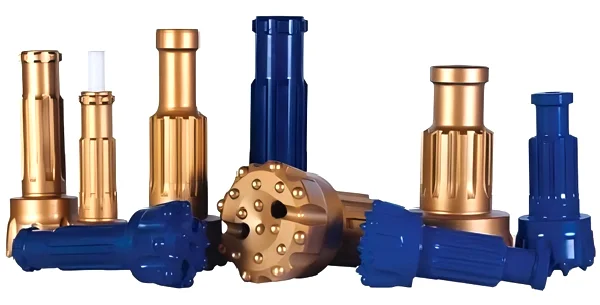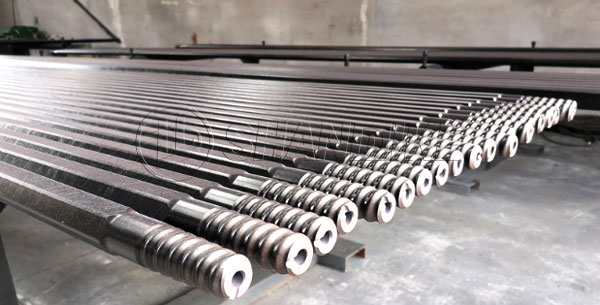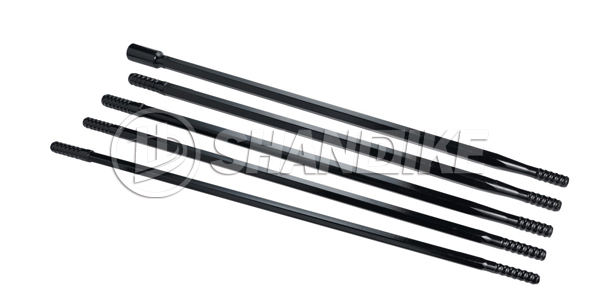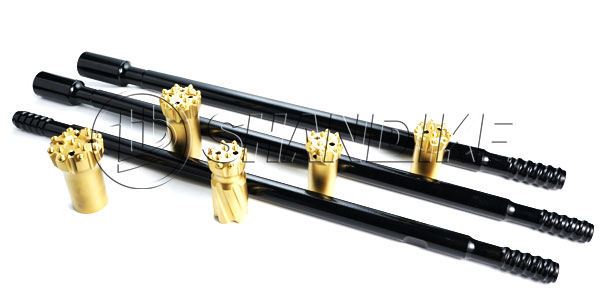Top Hammer vs Down-The-Hole Drilling Comparison
First, let us introduce the different characteristics of the two drilling tools.
Core Principle
Top Hammer (TH): The hammer/piston is mounted on the drilling rig above ground. It strikes the top of the drill string, sending shock waves down the rods to the bit.
Down-The-Hole (DTH): The hammer (including the piston) is located down the hole, immediately behind the bit. Compressed air drives the piston to strike the bit directly.

Differences & Characteristics
Comparison of two drilling technologies
| Feature | Top Hammer (TH) | Down-The-Hole (DTH) |
| Hammer Location | On the rig, above ground | In the hole, directly behind the bit |
| Energy Transfer | Impact travels down drill rods (energy loss with depth) | Impact directly on bit (minimal energy loss) |
| Optimal Depth | Shallow to Medium (Typically < 25m) | Medium to Deep (Effectively > 10m, often 100m+) |
| Hole Diameter | Small to Medium (Typically 35mm – 115mm) | Medium to Large (Typically 90mm – 300mm+) |
| Best Rock Type | Soft to Medium Hard | Medium Hard to Very Hard & Abrasive |
| Penetration Rate | Faster in soft/medium rock at shallow depths | Faster in hard rock & significantly faster at depth |
| Hole Straightness | Less accurate (deviation increases with depth) | More accurate & straighter holes |
| Water/Fluid | Dry drilling, or with air/flush mist | Handles wet conditions well (air flushes cuttings) |
| Noise/Vibration | High noise/vibration at the rig | Noise/vibration underground, quieter at surface |
| Dust Control | Requires good dust suppression (dry) | Air flush provides better dust control (into hole) |
| Bit Type | Cross-bit or Button-bit (shank adaptor) | Large, robust Button Bit (integral to hammer) |
| Setup/Complexity | Generally simpler rig setup | Requires larger air compressors, more complex hammer |
| Cost (Generally) | Lower capital cost (rig), higher rod wear cost | Higher capital cost (compressor/hammers), lower energy loss |

When to Use Which?
Choose Top Hammer (TH) When:
Drilling shallow holes (< 15-25m).
Working in soft to medium-hard rock.
Hole diameter is small (< 100mm).
Mobility and speed in shallow applications are critical (e.g., scaling, bolting).
Capital cost is a major constraint.
Precision hole straightness is less critical.
Choose Down-The-Hole (DTH) When:
Drilling deeper holes (> 10m, especially > 25m).
Working in hard, very hard, or abrasive rock.
Hole diameter is medium to large (> 90mm).
Hole straightness and accuracy are critical (e.g., production blasting, foundation piles).
Higher penetration rates in hard rock are needed.
Conditions are wet or require efficient cuttings removal.
Surface noise needs to be minimized.
Typical Applications
Top Hammer Tools:
Rock Bolting (Roof/ground support)
Scaling
Small-diameter Blast Holes (in softer rock/quarries)
Exploration Drilling (shallow)
Trenching
Anchoring (shallow)
Down-The-Hole:
Production Blast Holes (Mining, Quarrying – especially hard rock)
Large-Diameter Foundation Piling
Water Well Drilling
Deep Exploration Drilling
Geothermal Drilling
Piggyback Holes (Ventilation, backfill)
Conclusion
TH = Shallow & Fast (in soft rock): Best for smaller, shallower holes in softer formations where rig speed and lower upfront cost matter most. Energy loss limits depth effectiveness.
DTH = Deep & Hard: Essential for deeper holes, especially in hard rock, where direct energy transfer ensures higher efficiency, straighter holes, and superior penetration rates despite higher initial setup costs.
The choice fundamentally depends on rock hardness, required depth, hole diameter, precision needs, and budget. For deep holes in hard rock, DTH is almost always the superior choice. For shallow bolting or small holes in softer rock, TH is highly efficient.


